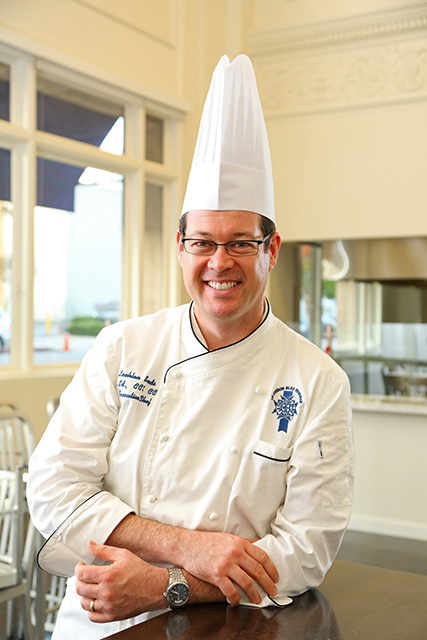[About Chef Lachlan Sands: Based on Chef Lachlan Sand’s extensive academic background, one would not have assumed that he would end up as the executive chef for a world well-known culinary school, Le Cordon Bleu. A double major in Biochemistry and History from University California of Berkeley led Chef Lachlan Sands to a career cooped up in a science lab. After seven years working in the science field and with the support from his wife, he decided to pursue his passion in cooking by enrolling at Le Cordon Bleu of Culinary Arts. Since 2008 he has climbed the ladder from six years as a Chef Instructor, one year as the Dean and two years in his current position as the Executive Chef. About Le Cordon Bleu of Culinary Arts: Referred as “The American Kitchen French” revolve their studies of baking and cooking through the influences of French cuisine. Their program also has a strong emphasis on learning the correct method of serving and even has a school operated restaurant called Technique in Pasadena. It is not just a vocational program, but students are able to obtain an Associate’s Degree. About 1600-2000 students are enrolled annually and about 200 of those are international students. The majority of the international students is Korean and is increasing.] Korea Herald: What is your experience with Korean Food? Chef Lachlan Sands: I’m going to warn you, my experience with Korean food is limited to Korean Barbeque (BBQ) and Bibimbap. Also, I personally love Kimchi. I have a jar at home. The one thing that differentiates Korean food from anything else, and this fascinates me because you have this one peninsula sticking out from China and basically sandwiched between China and Japan, but it still has a completely independent cuisine. It has an entirely and recognizably its own style of cuisine. KH: As a food expert, what advice would you give to Korean restaurant owners to help increase the influence of Korean food around the world? CLS: 1) Look at who you are marketing to and change your menu choice based on that. 2) Improve service. Focus on service by training people to give good service. The problem is people don’t know what is good service and bad service is. KH: What is the difference between food service and bad service? CLS: I expect to have excellent service in every restaurant that I go to. Excellent service means I am greeted, people are happy to explain the menu to me, they are happy to talk to me about what’s in the menu, and being treated like a guest in someone’s home. I don’t get that in a lot of restaurants, not just in Korean restaurants. I think service is a great way to dramatically improve the potential of restaurants. Focus on décor, focus on service, make it a place people would want to be and then they can feel comfortable to learn. The culture of service in Korean restaurants is different than perhaps other groups would expect. Two weeks ago, I went to a Korean restaurant. It was fine, I liked the food, the ban chan (Korean side dishes) was good but the server did not say one thing to us the entire night. There was no communication at all. KH: What did you mean by ‘look at who you are marketing to and change your menu choice based on that’? CLS: Well the nice thing about Korean food is that it’s immediately accessible because, in the form of Korean BBQ, it’s interactive. When you go out for Korean BBQ, it’s fun because you get to sit at a table and cook your own stuff. So, there’s an advantage right there. But the flavor profile is going to be difficult. So effectively, the question is, if I’m shooting to move towards a certain demographic, what am I going to have to do with the cuisine to keep it identifiable Korean but to change it to fit the palate of the group I’m appealing to? If you’re looking for Europeans, you need to reduce heat, the spicy heat. KH: But still maintain it, right? CLS: It can still be there, but just not to the same extent. It’s just a matter of identifying your target group and adjusting the profile to fit. So what do people such as Europeans expect from the generic Asian food? They expect soy and salty. Salty is a good place to start with soy or anything else, what they don’t expect is fermented flavors. |




